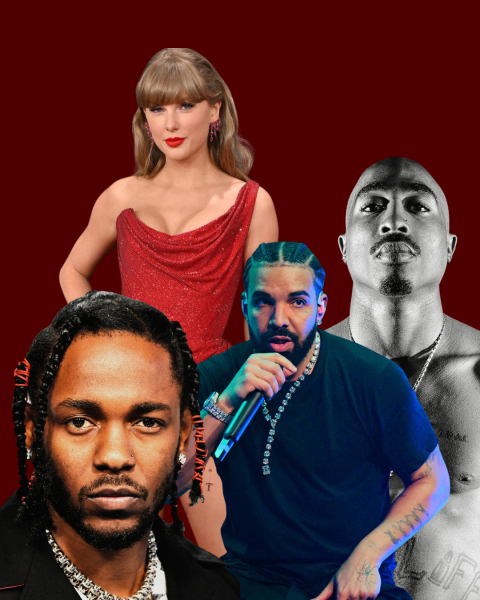
For decades, musical battles between artists have defined generations. Usually taking place in the hip-hop or rap genre, beefs between these artists have created many memorable diss tracks.
Diss tracks are songs written to “diss” another artist. The most recent example is Kendrick Lamar’s “Not Like Us,” which was written against Drake and his pedophilic allegations. The song had a tremendous year, awarding Lamar with Record and Song of the Year at the 2025
Grammys, becoming the first diss track to ever win this award.
Lamar even performed at the 2025 Super Bowl, where he sang “Not Like Us,” and in the performance, he called out Drake by name and looked at the camera when he said it.
Feuds date back far, dominating the 90s and 2000s. One of the most notorious feuds of the 2000s producing several diss tracks is the one taking place between Kanye West and Taylor Swift.
At the 2009 Video Music Awards, Swift was awarded Best Female Music Video for “You Belong With Me” when West stormed the stage and declared that Beyoncé should have won for “Single Ladies.” The moment became infamous in pop culture and is still talked about today.
West created the song “Famous” in 2016, which claimed he made Swift famous due to the infamous VMA incident. One year later, Swift dropped “Look What You Made Me Do,” which fans theorized attacked West and his then-wife Kim Kardashian for their years of hatred.
“Diss tracks can benefit the music world by letting artists express themselves and their feelings,” said Chloe Butts, a junior theatre major.
Swift has been known to write songs that inadvertently or pointedly call out someone, like her song “Bad Blood”, which had been said to be about pop singer Katy Perry. In response to “Bad Blood,” Perry released the song “Swish Swish,” a song about dodging haters, that is said to be about Swift.
A multitude of interactions via X, formerly known as Twitter, later, they finally buried the hatchet, and in 2019 Swift released the “You Need To Calm Down” music video which featured her and Perry sharing an embrace. The two are no longer feuding, and Perry went to Swift’s Eras Tour in 2023.
In the 90s, one of the biggest musical feuds erupted in the media, between famous rappers Tupac and Notorious B.I.G., also known as Biggie Smalls. Tupac and Smalls were previously best friends before they became hip-hop’s biggest rivals.
The two rappers’ beef is considered a major catalyst for the East Coast/West Coast hip-hop rivalry. In 1994, Tupac was robbed and shot, but not killed, after leaving a recording studio, to which he accused Biggie of having prior knowledge of the shooting.
The rivalry produced diss tracks like Tupac’s track “Hit ‘Em Up,” which was aimed at Biggie and the record label, and Biggie’s “Who Shot Ya?” as his response, which only ignited the feud further. The feud tragically ended when both their lives did, Tupac in 1996 and Biggie a year later.
“I think that diss tracks are very beneficial to the music world,” said Elizabeth Brosman, a junior theatre major. “They not only stimulate creation but also are able to express strong emotions. Music is all about expressing your emotions, and I think that is extremely prevalent in diss tracks, even if the emotions are considered negative.”
Artists have to express themselves creatively, and one way to do that is through diss tracks. If they are angry at someone else and can only find one way to get their point across, they can do it through song.
“They give people more insight on the artist’s point of view and perception of the other person to them,” said Imani Cooper, a sophomore graphic design major. “It can also reveal topics to the public that may not have been known previously.”

